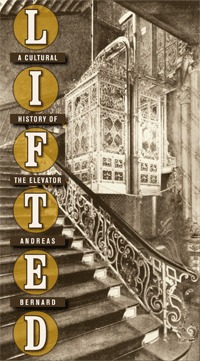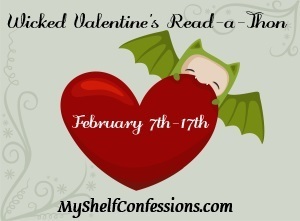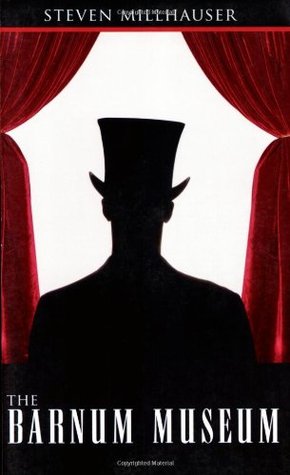Katherine Nabity's Blog, page 216
February 4, 2014
Review ~ Houdini
A modern day version of the Houdini brothers. Read about how Harry and Theo came into the world of magic and what happens when Harry is given the opportunity of a life time – the only stipulation being: Theo is to be left behind. Will Harry take this opportunity and how will Theo deal with knowing his brother could leave him? (via Goodreads)
I picked up this ebook back in December when it was released. In the authors notes, Ms. Kane relates that she was inspired to write this story after seeing the play Houdini, written by Stuart Brennan. I haven’t seen the play, but I frequent enough magic/magic history sites to have seen some press concerning it. My understanding is that is concerns the “Houdini Brothers,” as Ehrich and Theodore Weiss were known early in their careers, and what happened when Ehrich is given the opportunity to become Harry Houdini, the solo act.
I don’t know how accurate the play is historically. My impression has been that while Theo, rebranded as Hadeen, was never as successful as Harry, he had a pretty decent career in his own right, and there wasn’t bad blood between them. I could be wrong, I haven’t read all that much about Houdini and his family unrelated to my main subjects of magical interest. In the end, that is neither here nor there. My impression of the book, after reading the authors note, was that Charlotte L.R. Kane wished to write the story of two brother magicians set in the modern technological world. I’m good with that. That could be an interesting story, filled with YouTube and Twitter skullduggery. (Reading the Magic subreddit, it feels like the world of young magicians can be divided between the ones who use YouTube and the ones who loathe it.)
When writing reviews, I try to keep in mind cilantro and werewolves, but readers enter into reading with expectations. I expected magicians and magic. The characters are named Harry and Theo Houdini, but there isn’t much magic beyond that. The story could have as easily been about two singers, two actors, two stockbrokers. One brother becomes successful at the cost of other aspects of his life, one becomes obsessed with trying to be half as good at the cost of other aspects of his life. There is only small mention of Houdini’s signature tricks or magic at all. As a lover of systems, it’s also hard for me to get around the alternate universe aspects of this novella’s setup. Houdini and Hardeen were products of their time, and magicians today are to a slight degree products of Houdini (and Hardeen as well). I can close my eyes and let them be plucked from history, but their stories would be different.
The biggest problem with this ebook is that it felt very thrown together. Again, referencing the author’s note, Ms. Kane says she saw the play in September 2013. The book was released in December 2013. This novella was rushed and it absolutely shows. There are quite a few typos. The time period never feels like the 70s, 80s, 90s, or 00s. I couldn’t decide if this version of Harry and Theo were from New York or somewhere in England because the details were muddled. I’m not a die hard believer in “show, don’t tell,” but this was almost entirely the latter. This book was bland and poorly edited. Not a great way to kick off Indie Fever.
Publisher: Self-published.
Publication date: December 8, 2013
Genre: Literary fiction.
Why did I choose to read this book? Interest in magic and magic fiction.
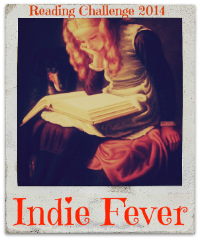


February 3, 2014
It’s Monday! What am I Reading? 2/3/14
 Hosted by Sheila at Book Journey
Hosted by Sheila at Book Journey
It’s Monday! What Are You Reading is where we share what we read this past week, what we hope to read this week…. and anything in between! This is a great way to plan out your reading week and see what others are currently reading as well… you never know where that next “must read” book will come from!
Happy Monday Everyone!
Read 1238 pages in January and finished three books. That’s little behind where I’d like to be, but, eh, reading and blogging are not my job. ;)
Reading This Week
Need to finish Mary Celeste.
Epoch 2 of The Woman in White
Start Lifted
A chapter of A Feast for Crows. Deal Me In story “Allies” by Katherine Dunn.
On the Blog This Week
Tomorrow, I’ll have a review of Houdini by Charlotte L.R. Kane. Thursday, I’ll hopefully have a review of The Ghost of the Mary Celeste, and Friday kicks off Wicked Valentine’s Readathon!


February 1, 2014
Deal Me In, Week 5 ~ Behind the Blue Curtain
Hosted by Jay @ Bibliophilopolis
“Behind the Blue Curtain” by Steven Millhauser
Card picked: Ace of Diamonds
From: The Barnum Museum (collection)
Review: As a kid, going to the movies was an infrequent enough occurrence that it was a treat. I remember going with my grandpa to summer matinees of children’s fare: Fantasia (in re-release), The Fox and the Hound, The Black Hole, The Last Unicorn. My parents took me to the Star Wars movies and Gremlins. (The Star Trek movies were reserved for their anniversary.) I remember catching a post-orthodontist-appointment showing of Bram Stoker’s Dracula with my mom during school hours because school would have been over by the time we crossed town. I saw Benny & Joon with friends on senior skip day. My grandma would often suggest 10pm showings of Patrick Swayze movies. She also had a fondness for Pauly Shore. None of these showings were at a grand movie palace. They were mostly at the Park 4 in Ralston. Flat seating, worn carpet in the lobby, but with four decent sized screens. I never experienced the days of ushers and curtained screens. I never had a taste of a movie palace until I went to college. While the Stuart theater didn’t have a curtain, it did have a glamorous lobby and, shockingly, only one screen. In college, there were 7 movie theaters with 15 first-run screens and 9 second-run screens within walking distance of where I lived. In college, movies were no longer a treat; they were a buffet.
I tell you this because “Behind the Blue Curtain” is about a boy who is allowed to go to a movie alone for the first time. While the entire outing is planned (his father will pick him up after the movie) the boys feels like he’s doing wrong just being the on his own in the darkened environment. His father has told him that movies are a string of stationary images projected in order fast enough that the eye sees these as movement, but the explanation isn’t enough for the boy. After the movie is finished, he is filled with curiosity and restless to truly transgress. He finds his way behind the blue curtain that hides the movie screen when movies aren’t being played.
The story’s dreamy qualities are juxtaposed with solid physical details. There’s a highly visual quality to story. Light, of course, gets a good amount of description in a tale about motion pictures. There is a journey from the bright summer afternoon, into the dark cool theater, and then to a different world of light behind the curtain.
About the Author: I’ve been seeing quite a few Millhauser stories being mentioned around the Deal Me In challenge. The Illusionist is one of my favorite movies, and, when I was trying to track down this collection a few years back to read “Eisenheim the Illusionist,” there didn’t seems to be a lot of Steven Milhauser to be found. I’m glad of the reversal though I’m not yet sure if I’d count him among my favorite short story authors. We’ll have to see, I guess.


January 31, 2014
What Else in January
 Read: 3
Read: 3
Print: 0
Ebooks: 3
ARCs: 1
Acquired:
The Candle Man by Alex Scarrow
Shirley by Susan Scarf Merrell
Eerie America by Eric R. Vernor and Kevin Eads
The Quick by Lauren Owen
It’s been a rocky start for the bookish resolutions. I forget myself and poof! Books appear. The bottom three are ARC and unfortunately I didn’t realize one is set to be published end of February instead of March, so it’ll impinge on the Triple Dog Dare challenge. So, just a Double Dog Dare?
In general, I haven’t read as much as I would have liked.
Writing Work

Been tending to Model Species out in the world. Started a re-read of Divine Fire and rewrote a scene–the editing has been bumped back to Eric for the time being. Oh, and rewrote a short story that’s been added to the premium edition of MS. Uploaded Model Species: The Apothic Edition today. It’s the thank-the-authors edition with a few extra goodies included, like the aforementioned short story, “A Game of Moths: A Tale by Gieter R. R. Morgan.”
Query-wise: Queried two new agents with Luck for Hire. Received two rejections (not from those agents).
Other Life Stuff
January has been full of ultimate frisbee. I’ve been a busy webmonkey, setting up competitive, instructional, and spring leagues. The last one has required the most attention. It’s bigger the planning gets hairy. But, draft is Monday and a new league will begin! Playing-wise, a Friday game has been added to our usual Wednesday game. When league starts, I’ll be playing MWF. Last weekend was New Year Fest. It’s the first time I’ve played in a tournament since 2007. Unfortunately, my body didn’t hold up. I played pretty well for the first three games on Saturday. The fourth game was terrible. I woke up on Sunday with every set of joints aching. Muscle pain, I can deal with. My hips aching? That’s probably the worst lately. But, Saturday was fun. Below is Maul – Masters Arizona Ultimate Ladies. We were going for fierce in this photo.

Photo courtesy Lisa Malo
January 28, 2014
#WilkieWinter ~ The Woman in White, Epoch I
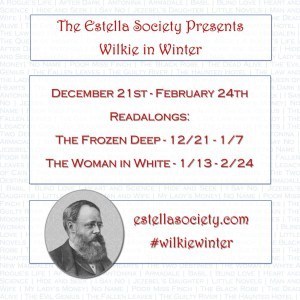
Hosted by The Estella Society
I first started reading The Woman in White last year for John Wiswell‘s National Novel Reading Month. I managed about half. It’s not that I didn’t enjoy the book, but it’s a bit of a slog and I seem to experience a slight reading slump in Jan/Feb. It feels like it happened last year as well. But! I soldier on. The following contains SPOILERS.
Considering my previous experience with the text, I decided to take some notes this time.
Walter Hartright – first author, teacher of drawing
Mother
Sarah, his sister. Doesn’t like Pesca
Professor Pesca – Italian, very short, language teacher, owes “life debt” to Hartright
Frederick Fairlie of Limmeridge House
Marian Halcombe, the dark one, half sister to Miss Fairlie. Talks like a 20s dame.
Miss Laura Fairlie, daughter of Mr. Fairlie, half sister to Miss Halcombe, niece to Frederick Fairlie (younger brother to Miss Fairlie’s father)
Mrs. Vesey, old governess
The mother of the Misses set up a school in Limmeridge
Mrs. Catherick, from Hampshire
Woman in White (Anne Catherick)
fears a Baronet
once happy in Cumberland, Limmeridge House and Village.
claims Mrs. Fairlie is dead, and her husband is dead, their little girl is married and gone (she isn’t). (presumably, this is Misses Halcombe and Fairlie’s mother and Miss Fairlie’s father)
two men looking for her, had given her lavender clothes, says she escaped from an Asylum.
Sir Percival Glyde
Vincent Gilmore, family solicitor
Magdalen, Arthur Fredrick’s daughter, cousin to Laura, far inheritor if Laura died single or childless.
Aunt Eleanor (Philip Fairlie’s sister)
Count FoscoLife-interest – On Mr. Frederick’s death, interest (3000 pounds/year) to Laura/Laura’s husband, inheritance of Limmeridge to his son.
On Laura’s coming of age: 20K plus 10K life-interest (to go to Aunt Eleanor on Laura’s death, to Magdalen if Eleanor dies first); after marriage, to her husband (interest), to children (principal), to Miss Holcombe, etc. (principal) — What Glyde wants: all of it.
To be honest, I’m still not clear on the money issue, aside from knowing that Glyde is doing something unreasonable and underhanded and, by the end of Epoch 1, Miss Fairlie and Miss Halcombe know nothing of it.
General impressions:
From the very beginning, it’s stated that this story involves a great injustice, possibly something litigious. There is also an ever-present cloud of foreboding. In what doesn’t seem to be retrospective, Mr. Hartright is reluctant to take the job at Limmeridge, even though his family is very keen about it. It is, I suppose, to be seen as the inciting event.
The repetition of Miss Fairlie walking outside while Miss Halcombe reads of Anne Catherick is spooky. There’s also an interesting juxtaposition between the anonymous letter and Miss Halcombe telling Mr. Hartright of Laura’s impending nuptials. As a reader, we are never given any choice but to think poorly of Sir Glyde. The Frozen Deep had a strong theme of predestination and its reversal. It’s not being harped on yet in The Woman in White, but many of the characters feel they have no choice in matters, at least if they don’t want to part from the ways of polite society. All of Laura Fairlie’s goodness works against her. And what did Glyde whisper in her ear?
Laura’s custodians utterly fail her, but again, their choices seem to be made by circumstances. All Laura wants (since she cannot have Mr. Hartright) is to not be parted from Marian Halcombe. She has no concern about her fortune, which is all everyone else seems to be interested in (aside from Miss Halcombe and Mr. Hartright, for whom it is only an impediment). Mr. Gilmore, a lawyer, only has reservations when it is the law that Glyde is manipulating.
Questions:
1. Class. Class plays such a huge part in this novel. Laura is obviously a higher class than Walter, but also higher than her sister Marian. How does this affect her relationships with the two characters? How does class enable Mr. Fairlie to be the, uh…grouch, that he is?
Unfortunately, class is the big impediment for Laura and Walter, and the aspect of novels of this time period that make me face-palm the most. Marian’s lower class seems to mean that she gets placed wherever someone else see fit. Not that she seems to mind, but she doesn’t really have any position in life other than as her half-sister’s companion. And then there is Mr. Fairlie. He uses his class to do whatever he pleases, which is mostly sitting in his darkened room with his collections and letting the rest of the world rot. If this had been a Shirley Jackson novel, Mr. Fairlie would quietly be poisoned (probably by his long-suffering servant, not the Misses) and everyone would be better off for it.
2. Sex. Marian is described as being manly. How does this affect her life? Laura is more womanly. How does this affect her?
Marian is given more leeway in how she can act. She’s often the go-between, the voice, and the researcher. In many ways, Marian is a more active character than Walter Hartright. Unfortunately, since she is still a woman, this doesn’t giver her much more freedom in decision-making. Laura is pretty much a pawn. Her efforts at being a good, true woman work against her. She tries to honor the promise her father made by appealing to Glyde’s generosity and finds that he has none. Her own virtue works against her since it gives Glyde no reason to end their engagement.
3. Sir Percival Glyde. What are your first impressions of Laura’s husband?
We’re never given any opportunity to think well of him. Even when the characters are given reasons to find him…reasonable, readers have been given every indication that he’s scheming to get Laura’s money. And what horrible thing did he whisper in Laura’s ear?!
4. Anne Catherick. What do you think of her? What is her part in this elaborate story?
I think Anne is a little simple and maybe a tad delusional. It sounds like she’s always been that way, but she’s probably been driven in that direction further, probably by Glyde. I won’t be surprised to find that she’s been stripped of a fortune by him too.
5. What do you think it would have been like reading this novel back when it was published? Do you think you would you feel different about the characters of Laura and Marian back then as opposed to how you feel about them now?
Reading this in 2014 America, the issues of class are more difficult to fathom. The consequences of Laura admitting that she can’t marry Glyde because of Walter are never even touched on, presumably because readers of 1860 would know that would play out. I imagine such a novel written now would include a digression on how fallen of a woman Laura might become if she goes against her family’s wishes. I am rather surprised at the character of Marian. She seems pretty outspoken for a female character of that era, even if she is the homely one.


January 27, 2014
It’s Monday! What am I Reading? (1/27/14)
 Hosted by Sheila at Book Journey
Hosted by Sheila at Book Journey
It’s Monday! What Are You Reading is where we share what we read this past week, what we hope to read this week…. and anything in between! This is a great way to plan out your reading week and see what others are currently reading as well… you never know where that next “must read” book will come from!
Happy Monday Everyone!
Haven’t been in an overly enthusiastic reading mood lately. It’ll pass, I’m sure. This week’s fare:
The Woman in White – Epoch 1 is “due” today and I still have 60 pages to read. Eee!
The Ghost of the Marie Celeste – Being released tomorrow and I’m only a quarter finished. Eee!
I believe the A Feast for Crows read-through begins at Tor this week. So, a couple chapters of that by Thursday.
And my Deal Me In selection for the week will be “Behind the Blue Curtain” by Steven Millhauser
I had a vague notion of getting a slim SF novel shoehorned in, but that’s doubtful.


January 25, 2014
Deal Me In, Week 4 ~ “Quicker Than the Eye”
Hosted by Jay @ Bibliophilopolis
“Quicker Than the Eye” by Ray Bradbury
Card picked: Two of Clubs
From: Tales of the Impossible, edited by David Copperfield & Janet Berliner
Review: Ray Bradbury brings me the first story of this challenge to involve stage magic–well, sort of. In this tale, an unnamed narrator watches as a man, who could be his twin, is duped during female pickpocket act.
This is a darker than I’m used to from Bradbury. Sure, sure, there’s the dystopian Fahrenheit 451 and the quiet menace of Something Wicked This Way Comes, but I’m not used to brittleness from Ray Bradbury. Our narrator is positively livid over the notion of a group of men being made fools of during a magic act, especially since one of those men is his doppelganger.
On one level this is what our reaction to being tricked should be. When a magician, or in this case a stage pickpocket with nimble fingers, takes advantage of us, we should be incensed. Usually, we’re not. When watching a magic act, the audience willingly decides to go along with being lied to. Personally, I’m not a fan of the mentalists and street magicians that do not present themselves with the sort of theatricality that is a nod to their fiction. I’m a bit dense and I dislike being tricked. Despite that, I really do enjoy magic. (I’ve also come to realize that I’d be a terrible magician because I am a terrible liar.)
Our narrator not only takes the pickpocket’s shenanigans personally, but is offended by the audience’s reaction. His fellow spectators are amused by a pretty woman, the same woman who has been sawed in halves and vanished from a box, stealing wallets, watches, neckties, suspenders, shirts, and pants. Bradbury obviously sets up a war-of-the-sexes. The men in the audience have been secretly satisfied to have seen this woman halved and disappeared, but it’s their wives and girlfriends that laugh loudest while the thiefess makes buffoons of the men. It’s these issues that I’m not used to from Ray Bradbury.
About the Author: Karmically, I feel I’m still paying for my re-pick a couple weeks back. Two weeks in a row and I pick two of my favorite authors. Who’s left? Ray Bradbury is probably the most read speculative fiction author of time thus far, highly anthologized and oft taught in schools. With his introduction to the Ray Bradbury Theater TV show, he made me realize that authors weren’t just names on the spines of books; that they are people and maybe I could be one too. Now, if only I could come close to writing as beautifully as he did.


January 23, 2014
Rewind ~ The Devil: A Biography
The Devil: A Biography by Peter Stanford
“The Devil’s deepest wile is to persuade us that he does not exist”.–Charles Baudelaire. But now, Peter Stanford’s highly readable survey brings the Devil to the forefront as he focuses on the Church, literature, folklore, psychology and history. The result is a lively account of our age-old response to the challenge of why evil and human suffering exist.(via Goodreads)
Recent discussions on Reddit have reminded me of one of my favorite non-fiction authors: Peter Stanford. I have a checkered history with The Devil: A Biography, the first book of his that I read. I checked it out from the library in 2002, didn’t finish it, and then purchased it at Powell’s in 2003*, but didn’t get around to reading it until May of the next year. This sort of thing is not uncommon for me.
From the 05/10/2004 entry:
I’ve moved on to reading more of Peter Stanford’s The Devil: A Biography. It’s an interesting book, it just got put aside. I can’t believe I started reading it in December of 2002, returned it to the library, bought it at Powell’s when we were in Portland last summer, and am just now getting back to finishing it.
The Devil: A Biography is a pretty inclusive look at the character and caricature of the devil. How much of the modern pitchfork-wielding devil is Biblical? Where did that image come from? What does any of that have to do with philosophies of evil and sin? It’s a pretty dense book, but one that’s engaging if pursued. Obviously, it took me a while to get into it, but I count it among my favorites.
* I’ve only visited Powell’s once, but this is what I hauled all the way home to AZ:
Green Shadows, White Whale by Ray Bradbury
Memos from Purgatory by Harlan Ellison
The War Poems by Siegfried Sassoon
Iona by Fiona Macleod
The Bird’s Nest by Shirley Jackson
The Haunting of Hill House by Shirley Jackson
(my paperback copy got wet in Florida, so it seems right that it should be replaced on another disc trip)
Red Dragon by Thomas Harris
The Devil: A Biography by Peter Stanford
The Good House by Tananarive Due


January 21, 2014
Review ~ Lightning
Drawn from the life of Nikola Tesla, one of the greatest inventors of his time, Lightning is a captivating tale of one man’s curious fascination with the marvels of science.
Hailed by the Washington Post as “the most distinctive voice of his generation,” Echenoz traces the notable career of Gregor, a precocious young engineer from Eastern Europe, who travels across the Atlantic at the age of twenty-eight to work alongside Thomas Edison, with whom he later holds a long-lasting rivalry. After his discovery of alternating current, Gregor quickly begins to astound the world with his other brilliant inventions, including everything from radio, radar, and wireless communication to cellular technology, remote control, and the electron microscope.
Echenoz gradually reveals the eccentric inner world of a solitary man who holds a rare gift for imagining devices well before they come into existence. Gregor is a recluse—an odd and enigmatic intellect who avoids women and instead prefers spending hours a day courting pigeons in Central Park.
Winner of the IMPAC Dublin Literary Award, Echenoz once again demonstrates his astonishing abilities as a prose stylist as he vividly captures the life of an isolated genius. A beautifully crafted portrait of a man who prefers the company of lightning in the Colorado desert to that of other human beings, Lightning is a dazzling new work from one of the world’s leading contemporary authors.(via Goodreads)
I purchased this volume from Our Book Store, small bookstore with an eclectic inventory in Omaha’s Old Market. I was drawn to it because it was small and slim and promised a story of a genius, “inspired” by the life of Nikola Tesla.
While this book is about a character named Gregor, it’s obvious that the story is about Tesla. Not to judge a book by its cover, but there are many other images one might have used if one wanted to invoke Tesla without using his portrait. Echenoz has written two other fictionalized biographies Ravel, about composer Maurice Ravel, and Running, about Czech runner Emil Zátopek. In these other cases, he didn’t bother trying to distance himself or the reader from the historical characters. Is this fictionalized biography more fictionalized than the others? The story does seem to exist pretty firmly in the eccentricities and myths of Tesla.
The writing and translation are lovely. The prose is light and funny, but often bittersweet and heartbreaking. The actions of Gregor aren’t too thoroughly explored. He is a master innovator who envisions his inventions fully formed. Sometimes he is great; more often he is impenetrable, not only to those around him but even to himself. Taken as novel, it’s fairly depressing. The genius of Gregor’s inventions are not given scope in light of his inauspicious end.
I’m a little dismayed that many reviewers seem to count this novel as an educational introduction to Tesla. The characterization of Gregor is less psychologically unbalanced than The Invention of Everything Else‘s Tesla, but the details are still cheery-picked for sensation. This narrative is by no means the complete story of Nikola Tesla, beautifully written as it is.
Publisher: The New Press
Publication date: 2010
Genre: Fictional biography, literary
Last review from a book read in 2013. Huzzah!


January 20, 2014
It’s Monday! What am I Reading? (1/20/14)
 Hosted by Sheila at Book Journey
Hosted by Sheila at Book Journey
It’s Monday! What Are You Reading is where we share what we read this past week, what we hope to read this week…. and anything in between! This is a great way to plan out your reading week and see what others are currently reading as well… you never know where that next “must read” book will come from!
Happy Monday Everyone!
Didn’t get a lot of reading done last week, so this week’s What Am I Reading looks a lot like last week’s.
The first third of The Woman in White is slated for discussion next Monday as part of Wilkie in Winter. I read the first two epochs last year, but I definitely need a refresher.
The Ghost of the Mary Celeste is due for release next week as well and I’d like to be timely with my review. So far, so good.
Tesla is firmly on the back burner. Thus far it’s a very systematic biography. I like that despite my lack of electrical engineering knowledge.
On the Blog
Review of Lightning coming tomorrow, sadly without the contrast of a real Tesla biography.






